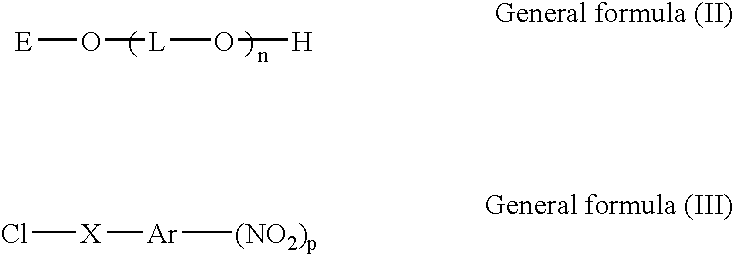Polyether derivative and process for producing the same
- Summary
- Abstract
- Description
- Claims
- Application Information
AI Technical Summary
Benefits of technology
Problems solved by technology
Method used
Image
Examples
example 1
Synthesis of the Representative Compound (1-1)
[0074]The representative compound (1-1) was synthesized by the following synthesis method.
[0075]A vacuum pump was used to dry 60 g (13.8 mmol) of polyethylene glycol monomethyl ether (“Uniox M-4000”, manufactured by NOF Corp., average molecular weight: 4350) at an outside temperature of 80° C. over 2 hours. 140 ml of acetonitrile and 3.8 ml (27 mmol) of triethylamine were added to the dried polyethylene glycol monomethyl ether under nitrogen gas flow. Next, a solution obtained by dissolving 2.82 g (15.2 mmol) of p-nitrobenzoylchloride in 50 ml of acetonitrile, was added to the solution in an ice bath in drips over a period of 30 minutes. Thereafter, the solution was stirred at room temperature for 2.5 hours, and then the solvent was distilled off. Thereto was added ethyl acetate, and the resultant solution was heated to 60° C. The solid undissolved was removed by filtration, and the filtrate was concentrated to yield a light yellow solid...
example 2
Synthesis of the Representative Compound (1–2)
[0078]Under nitrogen gas flow, a solution obtained by dissolving 0.56 g (2.99 mmol) of p-nitrobenzoylchloride in 20 ml of acetonitrile, was added in drips over a period of 10 minutes to a mixture of 14.95 g (2.99 mmol) of polyethylene glycol monomethyl ether (“20,251-7” available from Aldrich Co., average molecular weight: 5000), 40 ml of acetonitrile, and 0.42 ml (3 mmol) of triethylamine, which mixture was cooled in an ice bath. Thereafter, the solution was stirred at room temperature for 3 hours, and then the solvent was distilled off. Thereto was added ethyl acetate, and the resultant solution was heated to 60° C. The solid undissolved was removed by filtration, and the filtrate was concentrated to yield a light yellow solid. This solid was reprecipitated by using ethyl acetate so as to yield 12.3 g of a nitrobenzoyl derivative of polyethylene glycol monomethyl ether. The yield thereof was 79%.
[0079]Then, 11.9 g (2.29 mmol) of the re...
example 3
Synthesis of the Representative Compound (1–3)
[0081]A vacuum pump was used to dry 20 g (10.0 mmol) of polyethylene glycol monomethyl ether (“20,250-9” available from Aldrich Co., average molecular weight: 2000) at an outside temperature of 80° C. over 2 hours, and then thereto were added 50 ml of acetonitrile and 2.8 ml (20 mmol) of triethylamine under nitrogen gas flow. Next, thereto was added in drips in an ice bath over a period of 45 minutes a solution of 2.04 g (11 mmol) of p-nitrobenzoylchloride dissolved in 30 ml of acetonitrile. The solution was stirred at room temperature for 2 hours, and then the solvent was distilled off. Thereto was added ethyl acetate, and the resultant solution was heated to 60° C. The solid undissolved was removed by filtration, and the filtrate was concentrated to yield a light yellow solid. This solid was reprecipitated by using ethyl acetate so as to yield 20.5 g of a nitrobenzoyl derivative of polyethylene glycol monomethyl ether. The yield thereo...
PUM
| Property | Measurement | Unit |
|---|---|---|
| Temperature | aaaaa | aaaaa |
| Temperature | aaaaa | aaaaa |
| Dimensionless property | aaaaa | aaaaa |
Abstract
Description
Claims
Application Information
 Login to view more
Login to view more - R&D Engineer
- R&D Manager
- IP Professional
- Industry Leading Data Capabilities
- Powerful AI technology
- Patent DNA Extraction
Browse by: Latest US Patents, China's latest patents, Technical Efficacy Thesaurus, Application Domain, Technology Topic.
© 2024 PatSnap. All rights reserved.Legal|Privacy policy|Modern Slavery Act Transparency Statement|Sitemap



